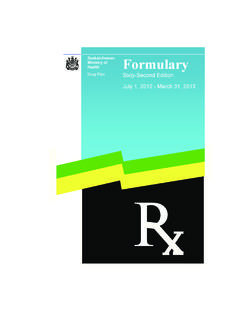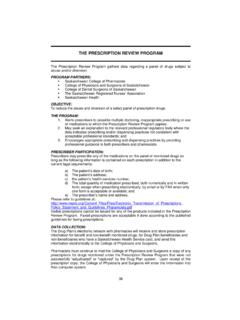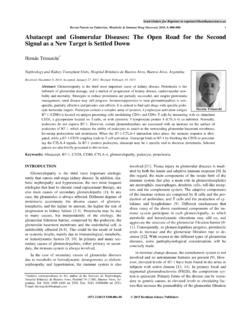Transcription of NOTES REGARDING THE EXCEPTION DRUG STATUS (EDS) …
1 1 APPENDIX A EXCEPTION drug STATUS PROGRAM NOTES REGARDING THE EXCEPTION drug STATUS (EDS) PROGRAM Duly licensed practitioners prescribing within their scope of practice (or authorized office staff) may apply for EDS. Requests can be submitted by telephone, by mail or by fax. A toll-free line with an electronic message system is available exclusively for requests on a 24-hour basis. The telephone number to access this line is 1-800-667-2549; the drug Plan EDS Unit fax number is (306) 798-1089. Patients are notified by letter if coverage has been approved and the time period for which coverage has been approved. If a request has been denied, letters are sent to the patient and prescriber notifying them of the reason for the denial. In most cases, the drug Plan requires more information to determine the patient's eligibility for coverage, and will reconsider coverage at such time as further information is received.
2 If the drug requested is not a benefit under the drug Plan, the patient and prescriber are notified. Payment for the medication is the responsibility of the patient in these cases. It is important to note that not all medications currently available on the market in Canada are benefits under the Saskatchewan drug Plan or under the EXCEPTION drug STATUS Program of the drug Plan. The majority of EDS requests are approved the date the request is received in our office. Requests for backdating can be made by a health professional or the patient. Patients are expected to meet EDS criteria within the dates requested. However, there is no provision or backdating further than one year from the current date. The drug Plan policy does not allow a fee to be charged to clients for EXCEPTION drug STATUS applications made to the drug Plan on the client's behalf. See NOTES CONCERNING THE FORMULARY, pages viii-xiii for additional general information REGARDING EXCEPTION drug STATUS coverage.
3 Coverage may be provided for other products in certain instances. REQUIREMENTS FOR REVIEW OF DRUGS FOR NON-APPROVED INDICATIONS On rare occasions drugs are required for non-approved indications on a case by case basis. In order to conduct a timely review of these requests the drug review committee requests the following information be provided by the prescriber: the disease or problem being treated list of previous therapies tried and the response achieved other non- EXCEPTION options available and why not appropriate name of the drug being requested clinical evidence to strongly support the use of the drug for the condition being treated outcome measures that will be followed to assess the effect of the drug dose of the drug and length of time to be used CRITERIA FOR COVERAGE UNDER EXCEPTION drug STATUS Following are the criteria for coverage of certain drugs under EXCEPTION drug STATUS . Approval of certain medications may be available online EDS adjudication or OEA.
4 With OEA, the drug Plan adjudication system will look for certain alternative medications, specific prescibers or age group in order to generate an automatic EDS approval. Please note: if a patient s computer profile is incomplete, OEA may not be possible and a traditional EDS request will be required. Professional staff at the drug Plan can provide further information on both EDS and OEA. 2 The following information is required to process all EXCEPTION drug STATUS requests: Patient name; patient Health Services Number (9 digits); name of drug ; diagnosis* relevant to use of drug ; prescriber name and phone number. *For pharmacist-initiated EDS requests: The diagnosis, which must be obtained from the physician or physician's agent, is to be consistently documented within the pharmacy, whether the documentation is on the original prescription, computer file, or EDS fax form. abacavir SO4, oral solution, 20mg/mL; tablet, 300mg (Ziagen-VII) (and listed generic) (possible OEA) For management of HIV disease.
5 This drug , as with other antivirals in the treatment of HIV, should be used under the direction of an infectious disease specialist. abacavir SO4/ dolutegravir/lamivudine, tablet, 50 mg/600 mg/300 mg (Triumeq VII) (possible OEA) For management of HIV disease in adult patients. This drug , as with other antivirals in the treatment of HIV, should be used under the direction of an infectious disease specialist. abacavir SO4/lamivudine, tablet, 600mg/300mg (Kivexa-VII) (and listed generics) (possible OEA) For management of HIV disease. This drug , as with other antivirals in the treatment of HIV, should be used under the direction of an infectious disease specialist. abacavir SO4/lamivudine/zidovudine, tablet, 300mg/150mg/300mg (Trizivir-VII) (possible OEA) (and listed generic) For management of HIV disease. This drug , as with other antivirals in the treatment of HIV, should be used under the direction of an infectious disease specialist. abatacept, powder for solution, 125mg/mlF pre-filled syringe (Orencia-BMY) (a) For the treatment of active rheumatoid arthritis in patients who have failed or are intolerant to methotrexate and leflunomide.
6 Note: This drug should NOT be used in combination with anti-TNF agents. abatacept, powder for solution, 250mg/vial (Orencia-BMY) (b) For the treatment of active rheumatoid arthritis in patients who have failed or are intolerant to methotrexate and leflunomide. Note: This drug should NOT be used in combination with anti-TNF agents. (c) For treatment of juvenile idiopathic arthritis in children who are intolerant to, or have not had an adequate response from etanercept. Initial treatment should be limited to a maximum of 16 weeks. Retreatment should only be permitted for children who had an adequate initial treatment response and subsequently experience a disease flare. Abilify - see aripiprazole acamprosate calcium, delayed release tablet, 333mg (Campral-MYL) 3 For alcohol use disorder in patients who have been abstinent from alcohol for at least four days and when the medication is being used as a component of an alcohol counselling program. Coverage will be reviewed every six months.
7 Accolate - see zafirlukast acitretin, capsule, 10mg, 25mg (Soriatane-HLR) (possible OEA) For treatment of: (a) Severe intractable psoriasis (b) Darier s disease (c) Ichthyosiform dermatoses (d) Palmoplantar pustulosis and other disorders of keratization. Aclasta - see zoledronic acid aclidinium bromide, powder for inhalation, 400ug (Tudorza Genuair-ACL) (possible OEA) For treatment of: a) COPD in patients unresponsive to short-acting beta agonists or short-acting anticholinergic bronchodilators, OR b) Moderate to severe COPD ( Medical Research Council (MRC) dyspnea scale score 3 to 5), in conjunction with spirometry demonstrating moderate to severe airflow obstruction ( FEV1 < 60 % and low FEV1/FVC < ), without a trial of short-acting agents. aclidinium bromide/formoterol fumarate dihydrate, powder for inhalation, 400ug/12ug (Duaklir Genuair-AST) For treatment of airflow obstruction in patients with moderate to severe COPD, as defined by spirometry, who have had an inadequate response to a long-acting beta-2 agonist (LABA), OR a long-acting muscarinic antagonist (LAMA).
8 Actemra - see tocilizumab Actonel - see risedronate sodium Actos - see pioglitazone HCl acyclovir, oral suspension, 40mg/mL (Zovirax-GSK) For patients unable to swallow the listed tablet formulation adalimumab, pre-filled syringe, 40 (Humira-ABV); pre-filled pen, 40 (Humira Pen-ABV) For treatment of: (a) active rheumatoid arthritis in patients who have failed methotrexate and leflunomide. (b) active rheumatoid arthritis in patients intolerant to methotrexate and leflunomide. (c) psoriatic arthritis in patients who have failed methotrexate and one other DMARD. (d) psoriatic arthritis in patients who are intolerant to methotrexate and one other DMARD. Note: Treatment should be combined with an immunosuppressant. This product should be used in consultation with a specialist in this area. Exceptions can be considered in cases where methotrexate or leflunomide are contraindicated. (e) For treatment of ankylosing spondylitis (AS) according to the following criteria: Initial Application (for a 12-week medication trial): 4 o For patients who have already been treated conventionally with two or more non-steroidal anti-inflammatory drugs (NSAIDs) taken sequentially at maximum tolerated or recommended doses for four weeks without symptom control; AND o Satisfy New York diagnostic criteria: a score 4 on the Bath Ankylosing Spondylitis Disease Activity Index (BASDAI) AND a score of 4 cm on the 0-10cm spinal pain visual analogue scale (VAS) on two occasions at least 12 weeks apart without any change of treatment.
9 Second Application (following the initial 12-week approval, requests will be considered for a one-year approval timeframe): o Adequate response to treatment assessed at 12 weeks defined as at least 50% reduction in pre-treatment baseline BASDAI score by 2 units AND a reduction of 2cm in the spinal pain VAS. Subsequent Annual Renewal Applications (beyond the first 15 months, requests are to be submitted annually for consideration of ongoing approval on a yearly basis): o The BASDAI score does not worsen ( remains within two units of the second assessment) AND remains at least two units less than the initial application s BASDAI score. NOTES : o Requests for coverage for this indication must be made by a rheumatologist. o Applications for this indication must be submitted on the designated EDS Application Ankylosing Spondylitis Drugs form found on the Formulary website. o Coverage may be provided for one switch for patients transitioning to another anti-TNF biologic agent following an adequate trial of the first agent if the patient fails to respond, if there is a loss of response, or is intolerant, to the first agent.
10 Approval will be subject to the published EXCEPTION drug STATUS criteria for the requested biologic agent. o Patients will not be permitted to switch back to a previously trialed biologic agent if they were deemed unresponsive to therapy. o Patients are limited to receiving one biologic agent at a time regardless of the condition for which it is being prescribed. (f) Crohn s disease as follows: Initially for a 6 month period: For the treatment of moderate to severely active Crohn s disease in patients refractory to or with contraindications to an adequate course of corticosteroids and other immunosuppressive therapy. Eligible patients should receive an induction dose of 160mg followed by 80mg two weeks later. Clinical response to adalimumab should be assessed after the induction dose. Ongoing coverage: Adalimumab maintenance therapy should only be provided for responders, as noted above, and for a dose not exceeding 40mg every two weeks. Patients undergoing this treatment should be reviewed every 6 months (g) For treatment of adult patients with severe debilitating plaque psoriasis who meet all of the following criteria: 5 failure to respond to, contraindications to, or intolerant of methotrexate and cyclosporine; AND failure to respond to, intolerant to or unable to access phototherapy.






